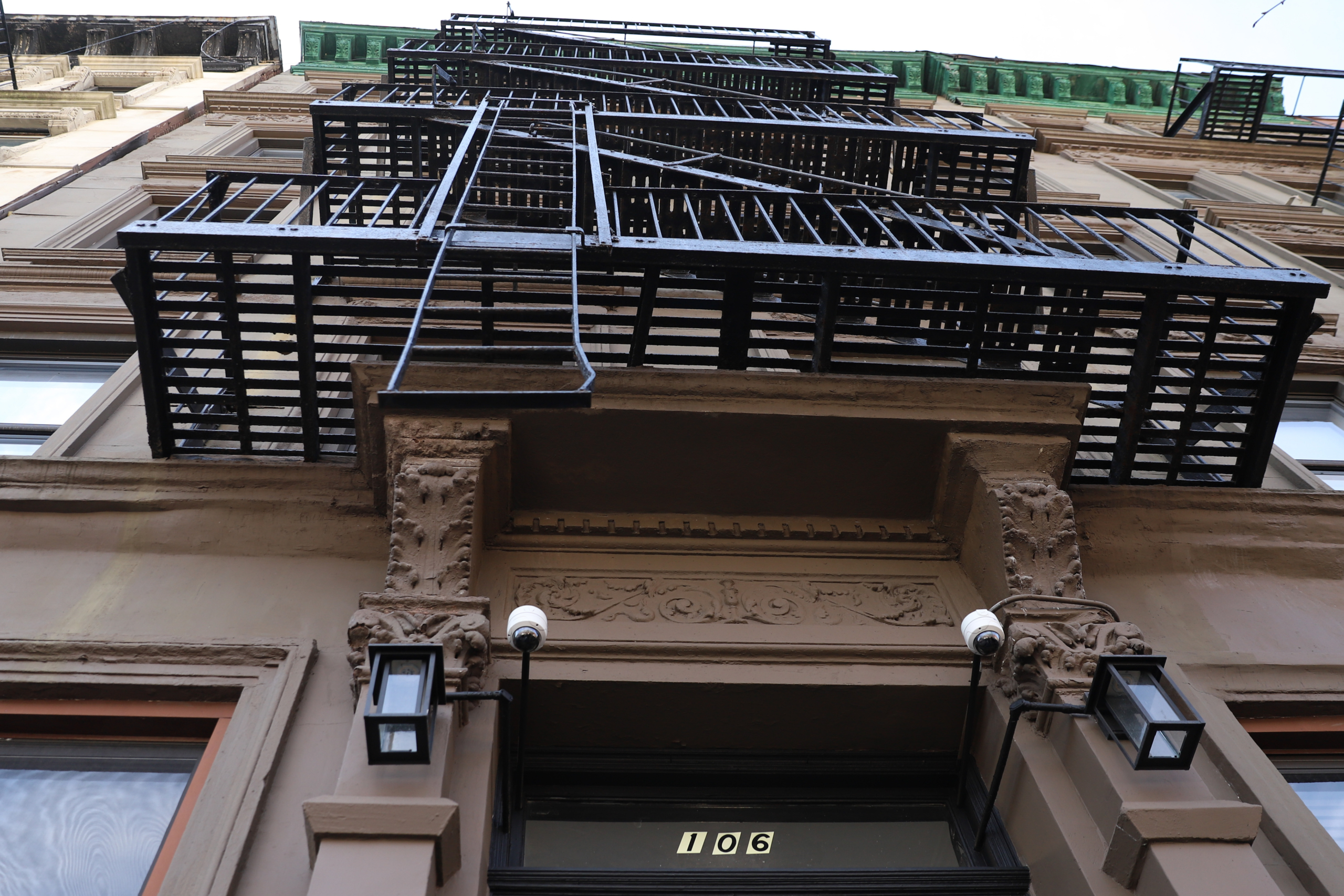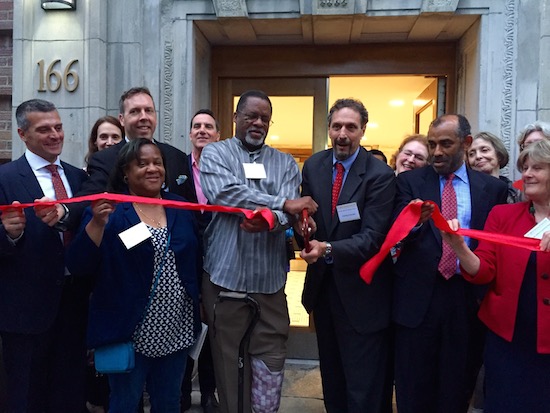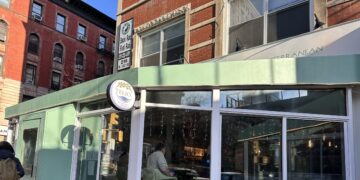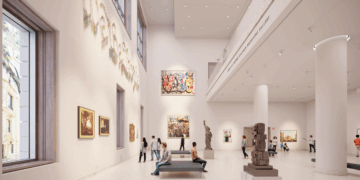
By Stephan Russo
I was the executive director of Goddard Riverside Community Center from 1998 to 2017, spending the bulk of my 40-plus-year career in community work there. I am also a longtime Upper West Sider and live next door to a supportive housing residence. I have witnessed the ebb and flow of the community’s response to homelessness up close.
When I first heard of the controversy about the safe haven planned for 106-108 West 83rd Street, I was stunned and transported back to an earlier era of my tenure. You see, I have a history with that building.
It was once called the Columbus Studios — one of many single room occupancy (SRO) residences on the Upper West Side, providing much-needed housing for low-income and elderly residents. The building is an 1893 tenement that was converted into SRO units in 1941. Despite often being rundown, buildings like Columbus Studios have been a vital component of our housing stock. But the city has lost over 100,000 SRO units since the early 1970s, according to several studies examining the impact of gentrification on low-income housing. One of the reasons many people find themselves on the street today is that they can’t find adequate, affordable housing. The decimation of SROs has contributed to this reality.
One of my first actions as the incoming executive director of Goddard Riverside in 1998 was to try to purchase 106-108 West 83rd Street and convert it into permanent housing, while protecting the tenancy of the existing residents. Unfortunately, I failed at convincing the owners that it was in their interests to sell. The housing would have been for the many street homeless people with whom Goddard Riverside was working through its then-named “Project Reachout” — the precursor to the Manhattan Outreach Consortium (MOC), which we organized in 2007 and continues to operate today.
In the mid-1980s, Project Reachout rented four rooms at the Columbus Studios to help stabilize people who were living on the streets and prepare them to live indoors permanently. The Safe Haven Program, initiated by HUD in the early 1990s, and of which there are now over 1,600 such housing units in New York City, is an effective interim step for those living on the street. Goddard Riverside’s program at Columbus Studios was a forerunner to this model.
Through MOC, Breaking Ground (who will run the 83rd Street Safe Haven and with whom I spent years collaborating), along with Goddard Riverside, and the Center for Urban Community Services (CUCS), provide street homeless outreach for the entire borough of Manhattan. Suffice it to say that through their efforts and the placement of homeless individuals into supportive housing, the program has been highly successful in getting people off the streets and reintegrated into the community.
At CB 7’s March 7th meeting discussing the safe haven, the cries of some that their children will not be safe, that the building will be filled with “sex offenders and drug dealers,” and that the community is saturated with such programs, were juxtaposed against other residents of the block who recognized that we are all safer when our fellow community members have roofs over their heads. I was pleasantly encouraged by the good will and spirit of inclusiveness of many of the public speakers.
To me, the most important aspect of this controversy is that we continue to preserve this form of housing. The negotiation as to the number of rooms and the level of services at the proposed safe haven will continue to play out in the public sphere. I believe we must recognize that many people coming off the streets want and need a reasonable degree of privacy, just as any of us would desire.
Perhaps my hope of 25 years ago will eventually come to fruition, and after the safe haven operates for a while, the current owner will finally sell the building to a group dedicated to providing permanency in the neighborhood — the ultimate answer to our continued debate about how best to respond to those who have no place to live.

When Stephan Russo retired from Goddard Riverside in 2016, West Side Rag profiled him. Read his fascinating story here. For his service, Goddard Riverside has honored Russo by naming a new supportive housing building on West 107th Street, The Stephan Russo Residence.









Thanks for the history. What a tough town this is, for the past few decades especially, that basic shelter should be so hard. Best wishes to the shelter, and to your vision of it as part of a non-profit housing program.
From volunteering for 20 years at the wonderful Thanksgiving and Christmas meals served at Goddard-Riverside for community members, some of them struggling, I came to know Stephan Russo a bit. What a great man! He has given SO much to our neighborhood and has my deepest admiration.
Thanks for your story & perspective Stephan! Hopefully our UWS neighbors and representatives will appreciate the benefits supportive housings provides.
Thank you for your efforts. They are much appreciated.
A number of the homeless are truly down on their luck and need basic help. But there are many with significant mental health and addiction issues. If activists would stop tripping over themselves to protect the “rights” of the latter group, more people would be supportive of helping the former group. Unfortunately, we never know which group we are going to get and very reasonably do not want to take a chance of getting the latter.
If you could promise me that the facility at 83rd Street would be for those with little or no criminal record, no substance abuse problems, and it would be well staffed with a zero tolerance policy, I would be OK with it. But you can’t. And I am not going to risk my child’s (or my own) safety to take this chance, particularly when there are a number of homeless who have these problems (contrary to the opinion of those who are in a state of denial about this).
You couldn’t fill this building with the number of single adults in the shelter system with no criminal record and no substance abuse problems.
Not sure I agree with you Peter. Many who use our shelter system are working one or more jobs, trying to make ends meet as busboys, deliverymen, or retail/construction work. If they lose an apt share situation, they rely on the shelter system until they can find another housing arrangement. Virtually all of these workers share living space with others, often living many to a room in bunk beds.
Meeting them or seeing them at work, you would have no idea they are homeless. This is a very different situation from the “street homeless” whose serious mental or substance use disorders that have alienated their families/friends and taken them out of the workforce. These people don’t use the shelter system because the shelter system does not tolerate that level of dysfunction. It’s my understanding that it is this population the 83rd St. Housing is attempting to serve.
Carlos I am confused. Why can’t Breaking Ground promise that the facility will have a zero-tolerance policy? This seems reasonable.
Fair question. They can promise that. But I don’t think they are willing to make that promise. So perhaps I should have said “But you won’t” instead of “But you can’t.”
Supportive housing tenants have leases and the associated protections. When you say zero tolerance, do you mean evicting someone? Without going through the appropriate process, that would be illegal.
West 83 is a shelter and not “supportive housing.” There is no lease. Many shelters have rules about drug use and curfews. The safe haven model has many less rules. Right now there aren’t lots of people hanging out there using or selling drugs and if so they are more discreet. Will it change and how will that affect the street? It is right across the street from the school?
Perspectives like this are necessary; people on here complain and say “why should folks down and out live in one of the most expensive cities around”, when they don’t realize, or empathize, that this city only very recently became a luxury/expensive location. The reason we have so many people on the street is because a generation ago they were all able to live in SRO’s among other spaces that were recently destabilized and made too expensive for most people nowadays.
Actually, that’s not true. Who do you think the brownstones were built for? Or the gorgeous buildings like the Astor, Apthorp, Ansonia, et all? They were built for the wealthy, not for policemen or firemen or teachers, or gasp the poor or the homeless!
And rents were more compatible with the wages of the working and middle class.
1) Will any ex-convicts be living in the safe haven? If so, will there be any class(es) of convictions (robbery, murder, sex offenses, violent assaults) that would disqualify them from eligibility?
2) Will any recently released parolees be living in the safe haven? If so, will there be any class(es) of convictions that would disqualify them from eligibility?
3) Will any persons currently experiencing substance dependency issues be living in the safe haven? If so, what type of therapy/counseling, and/or pharmaceutical interventions will be provided? How will compliance be ensured, or will compliance be optional?
4) Will any persons currently experiencing acute mental health issues be living in the safe haven? If so, what type of therapy/counseling, and/or pharmaceutical interventions will be provided? How will compliance be ensured, or will compliance be optional?
How do you know that there are no ex-convicts or parolees living in YOUR building? How WOULD you know? Have you taken a poll? Have you asked the landlord? Would you?
How do you know there are not persons currently experiencing substance dependency or acute mental health issues living in YOUR building? In fact, there probably ARE, since 3 out of 5 auld Americans are on some form of medication for either depression or anxiety, sometimes extreme.
Why the double standard?
What is unsaid is that many landlords will not take someone who they perceive to be a “problem” in their building. Or if its discovered, they’ll find a way to get these tenants out.
There’s no double standard.
If the city is going to place 108 convicted violent felons, recent parolees, untreated mentally ill persons, or drug addicts in MY building, I’m going to have a say about it.
Likewise, the neighborhood should have a say about this proposed placement, with community input, after all concerns have been aired and addressed.
Especially in light of how many similar facilities are here ALREADY, All the more so since this is being done with TAXPAYER dollars, at exorbitant cost, and in support of shady billionaire landlords who themselves have criminal convictions, with a stench of quid pro quo corruption hanging over the rising crime stats.
The sheer concentration of violent felons, mentally ill persons, and drug addicts being forced on the residents of the UWS is appalling, and is greatly diminishing the quality of life and any sense of safety in the neighborhood.
Homeless activists hurl red herrings at concerned residents of the UWS, as if we ourselves have no firsthand experience with homelessness, addiction, or serial criminals, when in fact we know FIRSTHAND of what we speak, and the dangers associated therewith.
Many of us know, from ourselves and our families, and understand the reckless folly of foisting a large, violent, untreated, unsupervised population into a neighborhood.
Care to provide proof for your claim that more than 150MM Americans are on this medication? And yes, I know that there are no convicts in my building, we do background checks.
The answer to all those questions is yes. Those are the people in the shelter system. They are in at least one of those groups.
These are excellent questions, and until they are answered no one can have an informed opinion about this project.
Reasonable Questions: Thank you. Succinct.
Sublime. Real. Courageous.
Mr Russo is getting his facts backwards.
He concedes that SROs were often “rundown” but he doesn’t mention that these SROs caused their neighborhoods to also be rundown.
As SROs began to close the neighborhoods they were located in became safer and cleaner and more desirable.
So it wasn’t “gentrification” that caused these SROs to close. The closure of these SROs led to gentrification.
Despite all the euphemisms and legal gymnastics the proposed shelter on 83rd Street is nothing more than an SRO.
It’s odd that Mr Russo seems to be nostalgic for a time when the UWS was gritty and dangerous and is intent on reverting to these times.
SROs were ubiquitous on the UWS above 86 (some lower than that) and the East Side above 96. Some have been renovated to the point where they can be rented or sold at market, the remainder of these old “hotels” are the source of our homeless shelters and supportive housing projects.
The difference between the 2 sides of the Park is that from 96 to 110 East of the Park it’s called “East Harlem” which is why the UES SEEMS to have very few of shelters. Hudson to East River, above 96, is where most are on both sides.
And going back 60 years, at least, the upper middle class residents of the UWS coexisted with the SROs, which were typically populated by “winos,” menial and day laborers, and the like. I’d sell them cheap pints of wine in my father’s store (a few feet from the 107 street SRO being debated today) before delivering higher priced goods to the likes of Hannah Arendt and Madeleine L’Engle. It was part of the neighborhood’s character, and remains so.
The residents of the supportive housing projects that exist in their stead have had no impact on the desirability of nearby condos and coops, indeed many of the owners of these units don’t even know there’s one a block away.
Well, you don’t have your history straight. The area I live in now (Morningside Heights) had more than one SRO in the ’70s. And it was safer than the Upper East Side residence I lived in ( and was mugged in more than once) growing up.
“Intent on reverting” …really? He is promoting supported shelter. Which people need. And the cycles of real estate flow in all directions. Landlords grab at gentrification and remodel when they think the market will support it. It‘s not even a generation since some “gentrifiers” were *bragging* about moving to Hells Kitchen because the gritty Lawrence Block detective novels were set there. Block’s fictional ex-cop alcoholic detective (if my unreliable memory serves) lived in an SRO near West 57th Street. (And his lady friend entertained her well-heeled clientele in her condo at the Parc Vendome…) People have problems, and well-staffed safe havens with services are a much better option than streets or shelters, and likely better than SROs. This building sounds like it will be seeing an improvement, for residents and for neighbors.
With the gentrification of the UWS, you end up bringing transplants from elsewhere who want a sanitized neighborhood. That’s just the reality of the situation we are facing.
Take a look at this article, might shed some light on what is going on. https://nymag.com/news/features/podolsky-homeless-shelters-2013-12/
Podolsky group makes a very nice living providing properties for homeless shelters/services.
https://eastsidefeed.com/real-estate/bentley-hotel-to-become-sanctuary-for-families/
Wow. Wow, wow, and wow. This NYMag article from 2013 should be required reading for anyone posting in this forum. Thanks for posting this link, which lays bare, collates, and summarizes so much of what we sense going on around us, even when we cannot see it.
We must not allow ourselves to be attacked by guilt-mongering ‘non-profit$’, who are in bed with the worst of the worst multi-millionaire slum landlords in the city. Strange bedfellows, indeed.
Remember: One man’s altrui$m, is another man’s paycheck.
Breaking Ground is the organization that will be running this 83rd Street facility.
The CEO of Breaking Ground, Brenda Rosen, earns close to $500K per year. The other officers of this organization also earn very large salaries.
I doubt there are any homeless shelters on the street Ms Rosen lives on.
Unfortunately, homelessness is a big and profitable and corrupt industry in NYC. Developers, lawyers and professional homeless advocates make big money.
Everyone else gets stuck with a dangerous homeless shelter in their neighborhood.
https://nonprofitlight.com/ny/new-york/common-ground-management-corp
“I doubt there are any homeless shelters on the street Ms. Rosen lives on.”
And you know this…how? And you base it on….what? In fact, I have people who live in my building – on West 83rd Street, thank you – who make over $500,000 per year, and have no issue with the proposed shelter.
Ad hominem attacks are a very weak argument for your case.
Your comments are not without their biases.
For full disclosure you should have noted that you’re a professional homeless advocate.
Not only does Brenda Rosen earn almost 500k a year as CEO she works only 12 hours a week.
While I admire Mr. Russo’s dedication to those less fortunate, I wish these advocates would be more sensitive to their neighbors with concerns. I have noticed on the UWS that new housing is either for the ultra-wealthy ($4.675M for 2 bedroom in the new building, The Westly), seniors (62+), or the indigent. Where are middle class people who are not elderly supposed to live?
How about one of the outer boroughs? There are lovely neighborhoods outside of Manhattan for people who aren’t snobs.
You are 100% correct.
Contrary to popular myth not all of NYC is unaffordable. For instance, you can buy a two bedroom apartment in a doorman building in safe areas like Riverdale and Forest Hills for less than the price of a studio on the UWS.
A friend of mine got tired of paying so much to live on the UWS so he recently moved to Riverdale. He now lives in a ginormous apartment with a balcony overlooking the Hudson River in a full service building.
Unfortunately, people feel entitled to live in neighborhoods they either can’t afford or choose not to pay full price for.
But if you’re in your 20s and 30s and don’t have kids, there is a social expectation that you must live in gentrified NYC. You want a romantic partner, you have to be able to make it in the “acceptable” parts of NYC. No person is going to want to go out to Forest Hills or Riverdale. One person told me they choose to live on the UWS because of networking and social opportunities that don’t exist in neighborhoods that are less trendy. You put this type of societal expectation on people in addition to taking parking spots away and failing to improve transit, at some point a discussion about rezoning the UWS and removing historic district protections in order to build more housing is going to have to be had.
Thank you Mr. Russo. Here’s hoping help for the disposed gets better!
[] yet another thing gentrification has to answer for.
[] per a very recent WSR report, once again, the upper east side fails to shoulder its share of fear, controversy and generosity.
I am truly perplexed by Goddard Riverside.
I have reached out to them numerous times about homeless folks on the street who are in desperate need of either drug or mental health assistance.
Folks that couldn’t tell you what city they were in or what year it is… and yet, these individuals who are danger to themselves, are still on the street and I don’t see any help being provided.
What no one ever discusses here is how much money the homeless industry pays themselves. I am offended when I see these ridiculous, high paying salaries for Not for profits and governmental jobs.
It would be nice if the Westside Rag could do an article on those salaries or would that ruffle too many feathers?
If the person refuses assistance, what do you expect the outreach team to do? It was good of you to put in the referral, but street homelessness is a complex issue and some folks refuse services.
I think “street homelesasness” is a complete misnomer, and the issue is not complex. The issue is that our severely mentally ill, drug addicts or alcoholics who can no longer function in society are free to self-destruct in public. No one can save them from themselves if they decide they want to self-destruct. This ruins everyone’s life, not just the unfortunate person who is ill. I think this is wrong. Until we bring back mental institutions (run properly this time) and make it simple to mandate treatment, we are in a doom loop.
I do not know who you mean by the “homeless industry”. I do know that the real profiteers are the private property owners real estate investors developers who buy up distressed buildings. Their business model is to then lease them back to the city to use as shelters short and long term, private and congregate, with and without supportive services at exorbitant profits. The not for profits such as Breaking Ground, Goddard Riverside. HELP USA, Community Access, Institute for Community Living etc. all have public tax filings. Their audited financials should be on their website or available on Charity Navigator. If you asked them, I expect they would be provided to you directly. We really must recognize the distinctions among private landlords, the very very few corrupt and unscrupulous not for profits (a couple have recently been prosecuted) which have exploited our desperate homelessness crisis, and the many dedicated non profits committed to serving the vulnerable. The 990 tax filing requires disclosure of the five highest paid staff and all of their other compensation. I chair the board of a non profit in the health care sector which operates several community based clinics. We lose staff all the time from our clinical, social work and other departments. These people labor under extraordinary pressures and difficult working conditions. They are offered very large salary increases by our standards paid bythe growing start up health tech sector, for profit urgent care chains and the big private hospitals or in the case of therapists they go into private practice and don’t have to accept the abysmally low reimbursement rates o Medicaid and Medicare.
Thank you Elizabeth. What an intelligent and informative comment. Economics are everything. We should not be outsourcing care to private industry, as it introduces the profit motive. See: our current healthcare system.
I hear you, but people should not be living in the most expensive city in the world with the least amount of space to find a home. We need to have much better distribution of poor and homeless in the country in inexpensive open areas. Going to expensive cities already in debt is not the answer.
Staten Islanders do a very good job at keeping the homeless and migrants out. They even oppose conservative restaurant owners serving them pizza. At least the UWS is better than that. https://gothamist.com/news/an-influx-of-migrants-has-divided-a-staten-island-neighborhood-the-natives-are-getting-restless
You’ve obviously not actually been to SI have you?
There is a huge problem with homeless in that borough, especially North Shore.
City is building or has built several shelters and there are plans for more.
https://www.silive.com/news/2022/11/three-staten-island-homeless-shelters-face-more-delays-but-still-set-to-open-during-2023.html
As someone who has lived on the UWS (and, in fact, on West 83rd Street) for over 55 years, what strikes me is that, while some of the “anti” people here are well-intentioned, most are essentially “fear-mongering.” That is something that UWSers NEVER did in the past, even when we had concerns about various policies or proposals. We expressed those concerns when we could, but also understood that not all of them COULD be addressed (for a variety of reasons) and that, in the “bigger picture,” the facilities were necessary.
In fact, the UWS has more shelters and other such facilities than all but two other areas in NYC for the very reason that we DID “welcome” them in most cases, because there was a broader sense of care and compassion in this community. And as someone else pointed out, the SROs and shelters did NOT make the community less safe, something which those of us who have lived here for decades can attest to as eyewitnesses. And it is not like we didn’t also have families, and children, to be concerned about. In fact, I was a child of 7 when my family moved here, and I never felt any fear of the people who lived in the SROs and shelters closest to me. In fact, my parents having taught us about “caring for the least of these,” I mostly felt sad.
Unfortunately, it seems that there has been in influx of people who think that the UWs should be some sort of “gated community” in which only those who can afford $8000 rents, half-million-dollar studios, or multi-million dollar apartments should be allowed to live here. The degree of “privilege” and “entitlement” I hear in some of these comments (I said “some”) is truly breath-taking.
I am only glad that the caring, compassionate UWSers still outnumber the others. 🙁
Maybe the UWS neighborhood that you grew up in is changing? Neighborhoods evolve. It doesn’t have to be on your terms just because you have been here a long time. Though I can understand why you would fight to preserve what you loved. But maybe it is changing?
The UWS is changing, rental to co-op/condo conversions helped make this, historic district landmarking helped make this, landlords preferring young professionals with no children as renters thus driving prices up helped make this. If anything the changes on the UWS are having a ripple effect that is much worse in outer borough neighborhoods that don’t get the special attention the UWS receives.
There is so much fraud, waste, abuse and political backroom dealings when it comes to homeless.
As with nearly everything else in this state and city it comes down to the incestuous and unhealthy relationship between politics and housing.
https://www.thecity.nyc/2023/4/13/23681238/frank-carone-yosef-zvieli-brooklyn-shelter